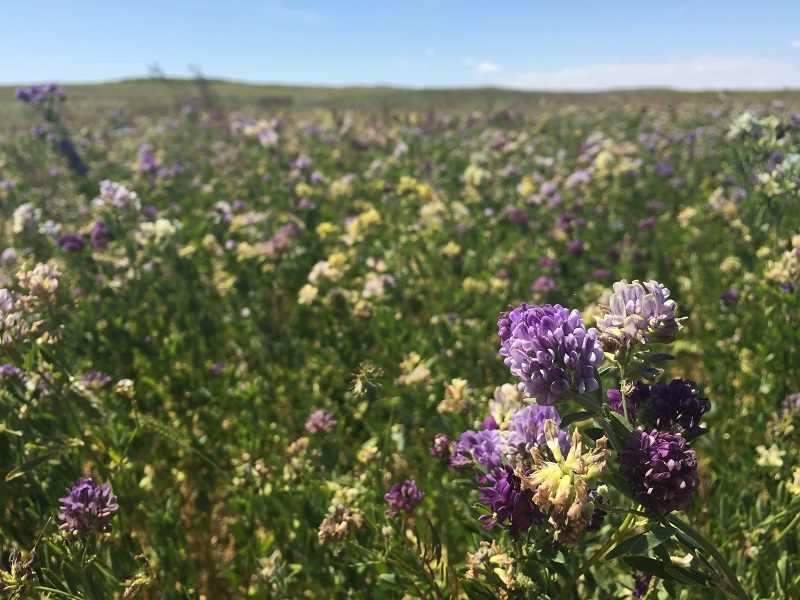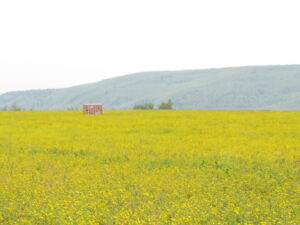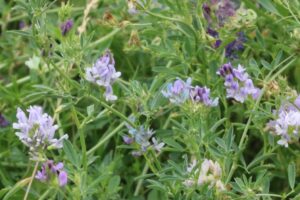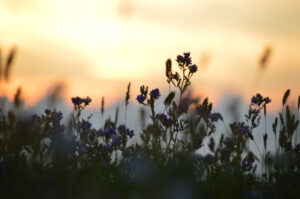Alfalfa for Canada’s Climate
This article written by Dr. Reynold Bergen, BCRC Science Director, originally appeared in the August 2022 issue of Canadian Cattlemen magazine and is reprinted on the BCRC Blog with permission of the publisher.

Very few of the alfalfa varieties sold in Canada were developed under Canadian conditions. The CFIA registered 119 varieties in Canada between 2012 and 2022, but only four (AAC Nikon, AAC Meadowview, AAC Bridgeview and AAC Trueman) were developed in Canada. The other 115 came from breeding programs in China, Australia, California, Washington State or Wisconsin, where winters are generally milder than most places in Canada.
Alfalfa’s winter survival depends on freezing tolerance and fall dormancy. Freezing tolerance is the ability to survive cold temperatures. Fall dormancy is when shorter days and cooler temperatures trigger alfalfa to redirect carbohydrates and proteins away from above-ground growth and towards the roots to power next spring’s regrowth. In current varieties, fall dormancy occurs during the four to six weeks before the first killing frost. Producers are advised not to graze or cut alfalfa during this period to avoid winterkill. Successfully reducing fall dormancy would shorten this critical period, lengthen the growing and grazing seasons, and increase alfalfa yields (provided it doesn’t compromise winter survival).
Selecting for reduced fall dormancy is easy – simply find and breed the plants that keep growing later into the fall. But selecting for winter survival in the field is challenging because nature doesn’t always provide conveniently severe winters (especially in warmer countries). Agriculture and Agri-Food Canada researchers Annick Bertrand and Annie Claessens and co-workers have developed a new method to screen alfalfa for lower fall dormancy and higher fall regrowth without sacrificing freezing tolerance or winter survival (“Multisite field assessment of fall dormancy, winter survival and yield of alfalfa populations selected for reduced dormancy within two cultivars using a new indoor screening method”).
What They Did

They started with two Canadian high-dormancy, winter-hardy alfalfa varieties. Peace is a purple-flowered variety selected for winter survival and yield that was released in 1980. Yellowhead is a Siberian variety that was selected for winter survival and yellow flower color and registered in 2007. The team grew Peace and Yellowhead alfalfa plants (2,000 of each variety) in a greenhouse under controlled light and temperature conditions, then reduced the artificial daylength and temperature to stimulate fall dormancy. They cut the alfalfa and allowed it to regrow for a month.
For each variety, the tallest 50% of plants (those that regrew the most and were least dormant) were cut and allowed to regrow again. This process was repeated three times, and then the 50 tallest Peace and 50 tallest Yellowhead plants were selected. These first-generation “reduced dormancy” populations were grown in field plots in Québec (St. Augustin and Normandin), Saskatchewan (Swift Current) and Alberta (Lacombe) along with the original Peace and Yellowhead parental generation. Total forage yield, plant height (dormancy) and winter survival were measured.
Freezing tolerance was evaluated under controlled conditions. The original Peace and Yellowhead varieties and their first-generation reduced dormancy populations were grown in pots (420 of each type). The plants were moved to a walk-in freezer, cooled to seven successively lower temperatures steps (from -2oC to -24oC), and held at each temperature step for 90 minutes. At each temperature step, 60 plants of each type were removed, thawed and regrown to assess survival and regrowth.
What They LEARNED

Field study: The first generation of reduced fall dormancy alfalfa regrew at least as well or significantly better after the last fall cut than their unselected Peace or Yellowhead parents. The reduced dormancy Peace population and its parental variety yielded the same, but the reduced dormancy Yellowhead yielded 40% better than its parental generation. No differences in winterkill were observed, suggesting that selection for reduced fall dormancy didn’t necessarily compromise winter survival under these natural conditions. For instance, the Lacombe plots, which experienced the harshest natural winter conditions that year, saw 0.8% to 4.8% winterkill rates in the reduced dormancy populations compared to 4% to 10.4% in the parental varieties.
Freezing tolerance tests: Selecting for reduced fall dormancy did not affect freezing tolerance in Peace alfalfa. Half of the reduced dormancy and parental populations died at -22.6oC. In contrast, selecting for reduced fall dormancy appeared to reduce freezing tolerance in Yellowhead alfalfa. Half of the parental Yellowhead variety was killed at was -24.0oC, while half of the reduced dormancy population died at -21.5oC.
This work will continue for at least four generations to confirm whether this breeding approach can improve yields of purple- and yellow-flowered alfalfas in northern climates without compromising winter survival.
So What Does This Mean… to You?

Private forage breeding companies have merged and consolidated just like the machinery, pharmaceutical, herbicide and packing sectors. Large multinationals focus their breeding efforts on their largest markets, not on developing high yielding, winter hardy varieties for small, regional markets like Canada. Fortunately, Canada’s public forage breeders are focused on improving perennial forages that can yield well and persist in our climate.
In the meantime, remember that if your first killing frost usually comes in mid-to-late September, your alfalfa needs four to six weeks before that to get its roots ready for winter and to power next spring’s regrowth. Grazing or harvesting alfalfa between early August and the first killing frost can weaken it and increase winterkill risk.
The Beef Cattle Research Council is funded by the Canadian Beef Cattle Check-Off. The BCRC partners with Agriculture and Agri-Food Canada, provincial beef industry groups and governments to advance research and technology transfer supporting the Canadian beef industry’s vision to be recognized as a preferred supplier of healthy, high-quality beef, cattle and genetics.
Click here to subscribe to the BCRC Blog and receive email notifications when new content is posted.
The sharing or reprinting of BCRC Blog articles is typically welcome and encouraged, however this article requires permission of the original publisher.
We welcome your questions, comments and suggestions. Contact us directly or generate public discussion by posting your thoughts below.